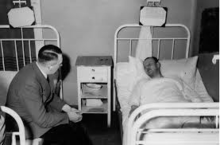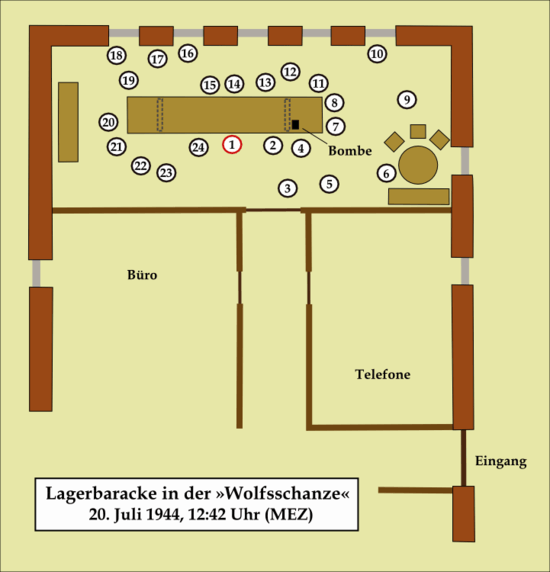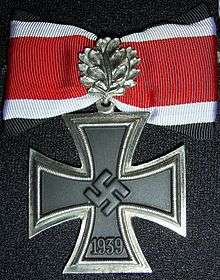Heinrich Borgmann
| Heinrich Borgmann | |
|---|---|
 Hitler visiting Heinrich Borgmann in hospital after the failed 20 July bomb, 1944 | |
| Born |
15 August 1912 Angermünde |
| Died |
5 April 1945 (aged 32) hospital in Magdeburg |
| Buried at | Waldfriedhof Dahlem |
| Allegiance |
|
| Service/branch | Heer |
| Years of service | 1932–45 |
| Rank | Oberst im Generalstab |
| Unit | Infanterie-Regiment 46 |
| Commands held | Volksgrenadier-Division "Scharnhorst" |
| Battles/wars | World War II |
| Awards | Knight's Cross of the Iron Cross with Oak Leaves |
Colonel Heinrich Borgmann (15 August 1912 – 5 April 1945) was a German Army officer who served in the Wehrmacht during World War II.
Biography
He is notable for being awarded the Knight's Cross of the Iron Cross with Oak Leaves and for being seriously injured by the 20 July plot bomb planted by Colonel Claus von Stauffenberg at the Wolf's Lair headquarters in Rastenburg, East Prussia.

He joined the infantry in 1932 and by the outbreak of World War II was a Hauptmann. He took part in the invasions of Poland in 1939 and France and he was awarded the Knights Cross of the Iron Cross (Ritterkreuz des Eisernen Kreuzes) for his role in the latter campaign on 19 July 1940. Borgmann was then posted to Eastern Front and was awarded the Oak Leaves to the Knight's Cross of the Iron Cross on 11 February 1942 when serving with Infanterie-Regiment 46. He was promoted to major and appointed to the Army Staff at Adolf Hitler's headquarters as an adjutant in October 1943 and was then promoted to Oberstleutnant.[1]
On 20 July 1944 he was standing at the end of the conference table close to von Stauffenberg's briefcase bomb. Generalmajor Rudolf Schmundt and Oberstleutnant Heinz Brandt who were standing to his left and stenographer Heinich Berger to his right were all killed by the explosion, but Borgmann survived with serious injuries. After recovering he was posted to an infantry division as an Oberst. He was appointed commander of the Volksgrenadier-Division "Scharnhorst".[1] Borgmann was killed during a low level air attack on his staff car in April 1945.[1]
Awards
- Iron Cross (1939)
- Infantry Assault Badge (3 October 1940)
- Eastern Front Medal
- Knight's Cross of the Iron Cross with Oak Leaves
- Knight's Cross on 19 July 1940 as Oberleutnant and chief of the 9./Infanterie-Regiment 46[3]
- 71st Oak Leaves on 11 February 1942 as Hauptmann and commander of the III./Infanterie-Regiment 46[3][4]
- Wound Badge 20 July 1944
References
Citations
Bibliography
- Fellgiebel, Walther-Peer (2000) [1986]. Die Träger des Ritterkreuzes des Eisernen Kreuzes 1939–1945 — Die Inhaber der höchsten Auszeichnung des Zweiten Weltkrieges aller Wehrmachtteile [The Bearers of the Knight's Cross of the Iron Cross 1939–1945 — The Owners of the Highest Award of the Second World War of all Wehrmacht Branches] (in German). Friedberg, Germany: Podzun-Pallas. ISBN 978-3-7909-0284-6.
- Hamilton, Charles (1984). Leaders & Personalities of the Third Reich. Volume 1. R. James Bender Publishing. ISBN 0-912138-27-0.
- Scherzer, Veit (2007). Die Ritterkreuzträger 1939–1945 Die Inhaber des Ritterkreuzes des Eisernen Kreuzes 1939 von Heer, Luftwaffe, Kriegsmarine, Waffen-SS, Volkssturm sowie mit Deutschland verbündeter Streitkräfte nach den Unterlagen des Bundesarchives [The Knight's Cross Bearers 1939–1945 The Holders of the Knight's Cross of the Iron Cross 1939 by Army, Air Force, Navy, Waffen-SS, Volkssturm and Allied Forces with Germany According to the Documents of the Federal Archives] (in German). Jena, Germany: Scherzers Miltaer-Verlag. ISBN 978-3-938845-17-2.
- Thomas, Franz (1997). Die Eichenlaubträger 1939–1945 Band 1: A–K [The Oak Leaves Bearers 1939–1945 Volume 1: A–K] (in German). Osnabrück, Germany: Biblio-Verlag. ISBN 978-3-7648-2299-6.
External links
- "Heinrich Borgmann". Ritterkreuzträger 1939–45 (in German). Retrieved 9 July 2011.
- "Heinrich Borgmann". World War II Awards. Retrieved 9 July 2011.
